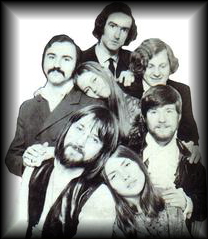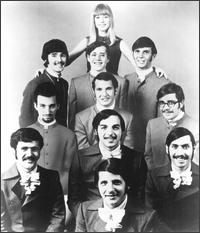
WIND in the WILLOWS lp '68 , featuring a very young DEBORAH HARRY
see page 3 for reviews of this band.....

promo shot of the band :)
One of the first things noticed in the biographies about Jesus' attitude toward women is that he taught them both the meaning of the Scriptures and religious truths in general. When it is recalled that in Judaism it was considered improper, and even "obscene," to teach women the Scriptures, this action of Jesus was an extraordinary, deliberate decision to break with a custom invidious to women. Moreover, women became disciples and followers of Jesus. (Luke 8:1ff) The significance of this phenomenon of women following Jesus about, learning from and ministering to him, can be properly appreciated only when it is recalled that not only were women not to read or study the Scriptures, but in the more observant settings they were not even to leave their household, whether as a daughter, wife, or member of a harem.
Within this context of women being disciples and ministers, Jesus quite deliberately broke another custom disadvantageous to women. According to the recorded eyewitness accounts Jesus' first appearance after his resurrection to any of his followers was to a woman (or women), who was then commissioned by him to bear witness of the risen Jesus to his disciples. According to Judaic law, women were not allowed to bear legal witness. Clearly this was a dramatic linking of a very definite rejection of the second-class status of women with a central element of the life of Jesus, the resurrection.
Not only did Jesus break Rabbinic laws of his day by teaching and talking to women, but he went even further. He allowed women to touch him--and women who were considered "unclean" by the society at that. Jesus touched a dead woman, the daughter of a synagogue ruler, and brought her back to life.
(Luke 8:40ff) He allowed a prostitute to touch and wash his feet while dining with a disapproving religious Pharisee. (Luke 7:36ff) And Jesus allowed a woman who had been bleeding for twelve years to touch his garment in order to be healed. (Matthew 9:20ff) As a woman with a flow of blood, she was considered constantly unclean, which not only made her incapable of participating in any cultic action and made her in some sense "displeasing to God," but also rendered anyone and anything she touched (or anyone who touched what she had touched!) similarly unclean.
On another occasion Jesus again deliberately violated the then common code concerning men's relationship to women. It is recorded in the story of the Samaritan woman at the well of Jacob. (John 4:5ff) Normally a Jew would not address a Samaritan, as the woman pointed out: "Jews, in fact, do not associate with Samaritans." But also normally a man would not speak to a woman in public (doubly so in the case of a rabbi). However, Jesus startled the woman by initiating a conversation.
The woman was aware that on both counts, her being a Samaritan and being a woman, Jesus' action was out of the ordinary for she replied: "How is it that you, a Jew, ask a drink of me, a woman of Samaria?" Jesus went on to reveal himself in a straightforward fashion as the Messiah for the first time. Just as when Jesus revealed himself to Martha as "the resurrection," and to Mary as the "risen one" and bade her to bear witness to the apostles, Jesus here also revealed himself in one of his key roles, as Messiah, to a woman.
His unpopular attitude toward marriage presupposed a feminist view of women; they had rights and responsibilities equal to men. It was quite possible in Jewish law for men to have more than one wife, though the reverse was not possible. Divorce, of course, also was a simple matter, to be initiated only by the man. Jesus rejected both by insisting on monogamy and the elimination of divorce. (Mark 10:2ff, Matthew 19:3ff).
Jesus' attitude toward women is also reflected in the very language attributed to him in the gospels. First, Jesus often used women in his stories and sayings, something most unusual for his culture. Secondly, the images of women Jesus used were never negative, but rather always positive--in dramatic contrast to his predecessors and contemporaries.
Thirdly, these positive images of women were often very exalted. Fourthly, Jesus often taught a point by telling two similar stories or using two images, one of which featured a man and one a woman. This balance, among other things, indicated that Jesus wanted it to be abundantly clear that his teaching, unlike that of other rabbis, was intended for both women and men--and he obviously wanted this to be clear to the men as well as the women, since he told these stories to all his disciples and at times even to crowds.
From this evidence it should be clear that Jesus vigorously promoted the dignity and equality of women in the midst of a very male-dominated society: Jesus was a feminist, and a very radical one.

thee BROOKLYN BRIDGE featuring JOHNNY MAESTRO, see page 2 for reviews....*